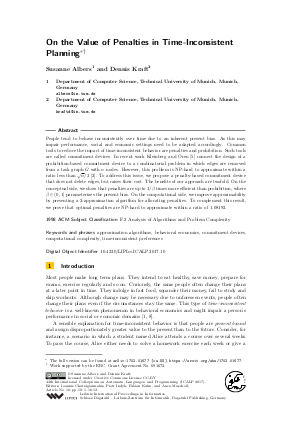On the Value of Penalties in Time-Inconsistent Planning
Authors Susanne Albers, Dennis Kraft
-
Part of:
Volume:
44th International Colloquium on Automata, Languages, and Programming (ICALP 2017)
Part of: Series: Leibniz International Proceedings in Informatics (LIPIcs)
Part of: Conference: International Colloquium on Automata, Languages, and Programming (ICALP) - License:
 Creative Commons Attribution 3.0 Unported license
Creative Commons Attribution 3.0 Unported license
- Publication Date: 2017-07-07
File

PDF
LIPIcs.ICALP.2017.10.pdf
- Filesize: 0.51 MB
- 12 pages
Document Identifiers
Subject Classification
Keywords
- approximation algorithms
- behavioral economics
- commitment devices
- computational complexity
- time-inconsistent preferences
Metrics
- Access Statistics
-
Total Accesses (updated on a weekly basis)
0PDF Downloads0Metadata Views
Abstract
People tend to behave inconsistently over time due to an inherent present bias. As this may impair performance, social and economic settings need to be adapted accordingly. Common tools to reduce the impact of time-inconsistent behavior are penalties and prohibition. Such tools are called commitment devices. In recent work Kleinberg and Oren [EC, 2014] connect the design of a prohibition-based commitment device to a combinatorial problem in which edges are removed from a task graph G with n nodes. However, this problem is NP-hard to approximate within a ratio less than n^(1/2)/3 [Albers and Kraft, WINE, 2016]. To address this issue, we propose a penalty-based commitment device that does not delete edges, but raises their cost. The benefits of our approach are twofold. On the conceptual side, we show that penalties are up to 1/beta times more efficient than prohibition, where 0 < beta <= 1 parameterizes the present bias. On the computational side, we improve approximability by presenting a 2-approximation algorithm for allocating penalties. To complement this result, we prove that optimal penalties are NP-hard to approximate within a ratio of 1.08192.
Cite As Get BibTex
Susanne Albers and Dennis Kraft. On the Value of Penalties in Time-Inconsistent Planning. In 44th International Colloquium on Automata, Languages, and Programming (ICALP 2017). Leibniz International Proceedings in Informatics (LIPIcs), Volume 80, pp. 10:1-10:12, Schloss Dagstuhl – Leibniz-Zentrum für Informatik (2017)
https://doi.org/10.4230/LIPIcs.ICALP.2017.10
BibTex
@InProceedings{albers_et_al:LIPIcs.ICALP.2017.10,
author = {Albers, Susanne and Kraft, Dennis},
title = {{On the Value of Penalties in Time-Inconsistent Planning}},
booktitle = {44th International Colloquium on Automata, Languages, and Programming (ICALP 2017)},
pages = {10:1--10:12},
series = {Leibniz International Proceedings in Informatics (LIPIcs)},
ISBN = {978-3-95977-041-5},
ISSN = {1868-8969},
year = {2017},
volume = {80},
editor = {Chatzigiannakis, Ioannis and Indyk, Piotr and Kuhn, Fabian and Muscholl, Anca},
publisher = {Schloss Dagstuhl -- Leibniz-Zentrum f{\"u}r Informatik},
address = {Dagstuhl, Germany},
URL = {https://drops.dagstuhl.de/entities/document/10.4230/LIPIcs.ICALP.2017.10},
URN = {urn:nbn:de:0030-drops-73876},
doi = {10.4230/LIPIcs.ICALP.2017.10},
annote = {Keywords: approximation algorithms, behavioral economics, commitment devices, computational complexity, time-inconsistent preferences}
}
Author Details
References
-
George A. Akerlof. Procrastination and obedience. The American Economic Review, 81(2):1-19, 1991.

-
Susanne Albers and Dennis Kraft. Motivating time-inconsistent agents: A computational approach. In Proceedings of the 12th Conference on Web and Internet Economics, pages 309-323. Springer, 2016.

-
Gharad Bryan, Dean Karlan, and Scott Nelson. Commitment devices. Annual Review of Economics, 2:671-698, 2010.

-
Nick Gravin, Nicole Immorlica, Brendan Lucier, and Emmanouil Pountourakis. Procrastination with variable present bias. In Proceedings of the 17th ACM Conference on Economics and Computation, pages 361-361, New York, NY, USA, 2016. ACM.

-
Jon Kleinberg and Sigal Oren. Time-inconsistent planning: A computational problem in behavioral economics. In Proceedings of the 15th ACM Conference on Economics and Computation, pages 547-564, New York, NY, USA, 2014. ACM.

-
Jon Kleinberg, Sigal Oren, and Manish Raghavan. Planning problems for sophisticated agents with present bias. In Proceedings of the 17th ACM Conference on Economics and Computation, pages 343-360, New York, NY, USA, 2016. ACM.

-
David Laibson. Golden eggs and hyperbolic discounting. The Quarterly Journal of Economics, pages 443-477, 1997.

-
Ted O'Donoghue and Matthew Rabin. Doing it now or later. The American Economic Review, 89:103-124, 1999.

-
Ted O'Donoghue and Matthew Rabin. Incentives and self control. Advances in Economics and Econometrics: The 9th World Congress, 2:215-245, 2006.

-
Pingzhong Tang, Yifeng Teng, Zihe Wang, Shenke Xiao, and Yichong Xu. Computational issues in time-inconsistent planning. In Proceedings of the 31st AAAI Conference on Artificial Intelligence, 2017. To appear.

